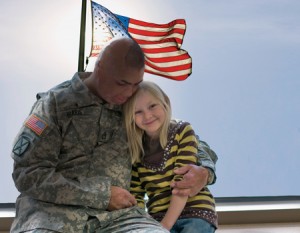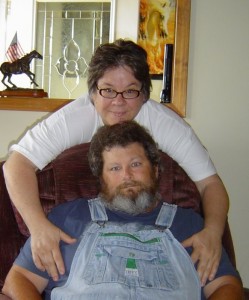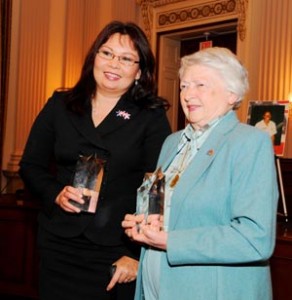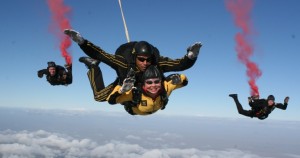
SSG (R) Shilo Harris with his daughter, Lizzie. Harris inspired wounded warriors and employers at the 2010 AW2 Career Expo.
By Emily Oehler, WTC Stratcom
When the AW2 Career Expo participants and employers first saw retired SSG Shilo Harris, they noticed his severe burns—no ears, a remade nose, little hair, scars, missing fingers, patched up skin. But when they listened to him speak during lunch, they only saw the strength of a Soldier, the love of a husband and the compassion of a man.
At 27, Shilo Harris joined the Army. “I wanted to go to combat even though I had a wife and kids. After 9/11, I knew I had to do something,” Shilo told the AW2 Symposium delegates and Career Expo employers. “I am proud of what I was a part of in Iraq and in the Army.”
For Shilo, February 19, 2007, was a day like any other, “we were running the roads building rapport with the locals—traveling along a road filled with IED holes the size of a VW bug.” An IED exploded under his truck killing his gunner and two dismounts and injuring the driver and Shilo in the front passenger seat. “We lost three great Soldiers, great Americans that day.”
“It rung my bell pretty good—and then I felt hot. I looked down and saw that the uniform on my right arm had melted into my skin like plastic,” Shilo explained. After the IED exploded, an AT4 exploded inside the Humvee creating a tornado of fire around Shilo.
As one Soldier performed combat lifesaving measures on Shilo, he remembers looking over at his mangled left hand thinking, “Man, I better get a day off for this.” Laughing, “You see we didn’t get many days off in Iraq.”
Kathreyn Harris, his wife, then shared her part of their story. “I knew when his commander called me personally that Shilo had done it up right with this injury—he gave everything his all, even getting hurt. He had third degree burns over one-third of his body and a C7 spinal fracture.”
She went on, “There I was the next day leaving my three year old daughter on the couch screaming with her grandparents not knowing what I was getting into as I left for Landstuhl to meet Shilo.” After seeing Shilo she explained, “with all the machines to keeping him alive and all the medicines keeping the infection down, everything changed. My focus now was to get my husband better so that he’d be with us for the rest of our lives.”
Fifty-one days in ICU, 45 of which Shilo was in a medically induced coma, then 17 days in a step down unit, then 4-6 hours a day of wound care, then learning to do everything again. As they stood together in front of the audience, Shilo with his hand on her back, Katherine stated, “We gained his independence back together.”
Shilo closed his remarks by charging the AW2 Symposium delegates, wounded warriors with their spouses, to “take advantage of this opportunity to improve care now and for years to come.” The delegates will spend the upcoming week identifying the top warrior care and transition issues that severely wounded, ill and injured Soldiers, Veterans and their Families face and provide recommendations on how the Army and other government agencies should resolve them.
“As you leave here, I’m begging you, go back and be a productive member of your community. Please be leaders in your communities—and know, this is not the end of the road, this is just the beginning.”






